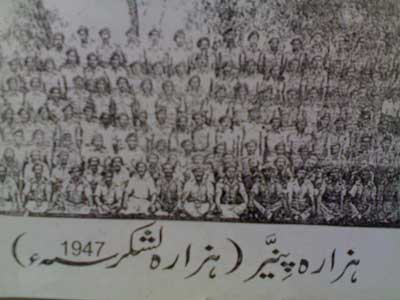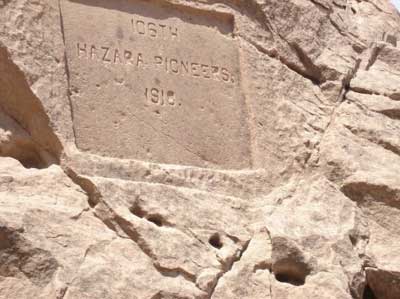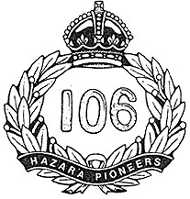|
The Hazara Pioneers (1904)
(courtesy: The Hazaras by Hassan Poladi)

The first contact between the British and the Hazaras seems to have been just before the First Afghan War, when some Hazara served in "Broadfoot's Sappers" (British Scouts) in about 1839-1840.
For many years a considerable number of Hazaras used to come to India to work as laborers, particularly at heavy work such as quarrying. In 1903-1904, however, owing to extreme persecution by the Afghans, large
numbers of Hazara refugees poured over the frontier. In 1904, Lord Kitchner, who at that time was Commander-in-Chief in India, directed Major C. W. Jacob to raise a battalion of Hazara Pioneers. Previous to this, the only
Hazaras in the Indian Army were those enlisted in the 124th and 126th Baluchistan Infantry and a troop in the Guides Cavalry.
The 106th Hazara Pioneers were raised at Quetta in 1904 by Major C. W. Jacob; a nucleus was formed by drafts from the 124th Duchess of Connaught's own and the 126th Baluchistan Infantry. The Battalion was composed of eight companies of Hazaras, and their permanent peace station was at Quetta. Their full dress uniform was drab with red facings.
In 1918 the Hazaras of the 124th and the 126th Baluchistan Infantry were transferred to the 106 Hazara Pioneers, then on active service Mesopotamia. Prior to this, the Guides Cavalry had ceased to include Hazaras in their ranks. The 106th Hazara Pioneers were now the only unit in the Indian Army enlisting them.
There were two changes in the title of the regiment after the 1914-1918 war. The 106th Hazara Pioneers became "The 1st Battalion 4th Pioneers" in 1922 and the "The Hazara Pioneers" in 1929. As a result of the financial crisis in 1933, all Pioneer Regiments in the Indian Army, including the Hazaras Pioneers, were disbanded.
Since the 1914-1918 war, it had become increasingly difficult to recruit Hazaras from the Hazarajat; more recruits had to be taken from the Hazara colonies settled in the Mashhad area. These men, however,
lacked many of the best qualities of the Hazaras enlisted from the Afghan highlands, directly. The difficulty in obtaining more of the latter was due chiefly to the change in the attitude of the Afghans towards the Hazaras who
were no longer poorly treated and were now being freely enlisted in the Afghan Army. In addition, the Afghan government had requested the government of India not to continue enlisting their subjects (the Hazaras) in the Indian
Army.
Field Marshall Sir Claud W. Jacob was colonel of the regiment from 1916 until its disbandment in 1933.
In 1915, one company served with distinction in France with the 107th Pioneers. The whole regiment was employed during 1915-1916 with the Kalat Column, and at Khwash in Sistan under General Dyer. In 1917 they served on the Mohmand Blockade Line, and sent one company to join the 128th Pioneers in Mesopotamia.

The Hazara Pioneers memorial somewhere in France (courtesy: Saleem Javed)
In 1918, the whole regiment proceeded to Mesopotamia where, after serving for some months with the 18th Indian Division on the Tigris above Baghdad, they joined the 2nd Corps and were employed in helping the drive the railway through the Jabal Hamrin from Table Mountain on the Dajla (Tigris River).
During 1919, they worked strenuously on the Shergat-Mosul Line of Communications. In the autumn they took part in the Kurdistan Operations. In 1920, they were again employed on the Shergat-Mosul Lines of
Communications, completing their labors in 1921 by constructing a new road down the bank of the Tirgris from Shergat to Baji. They returned to Quetta in August 1921.
During the above operations, several Indian Orders of Merit, as well as a number of Indian Distinguished Service Medals and Indian Meritorious Service Medals, were awarded to Hazaras for gallantry.
During the Waziristan Operations of 1923-1924, the Hazara Pioneers took part in the road making through the Baravi Tangi and the Shahur Tangi. This was difficult work, which had to be completed against time.
Afterward, they did considerable work on the railway and on frontier roads in Zhob.
In 1917, due to the difficulty of enlisting a sufficient number of Hazaras from Afghanistan, the experiment was made of recruiting Baltis as a temporary measure. A recruiting party from the 106th Hazara Pioneers visited Baltistan in the late autumn of 1917. About 100 recruits were enlisted during 1917-1918 and even brought to Quetta for training, but the war ended before any of them were able to join the regiment overseas. After the armistice, nearly all these Baltis were demobilized and returned to their homes.
The Hazara Pioneers were probably the best shooting regiment in the Indian Army. The men were naturally good shots and were tremendously keen. At the Divisional Rifle Meetings in Quetta, at least half the men in
the battalion entered the open events and swept the board year after year. They won the Meerut Cup and King Emperor's Cup on several occasions, as well as the Carnatic Gold Cup and the Rawlinson Sheild.
Although the Hazara Pioneers always had talented individual field hockey payers, it was not until after the Great War that they produced good teams. Their post-war successes were due mainly to the fact that the
young soldiers from whom the teams were drawn, had been born and bred in the Hazara Lines in Quetta. They won a succession of District Hockey Tournaments and in 1926 also carried off the Western Command Hockey Cup. In the same
year, two of their teams were chosen for the Indian Army hockey team, which had such a successful tour in New Zealand.
|
|
Brief History ( Source )
The original 6th Bombay Infantry was disbanded in 1882. It was raised in 1775 and earned honours for Mysore and Seringapatam. Their uniform originally had black facings. In 1904, Major C W Jacob of the 126th Baluchistan Infantry and later to become Field-Marshal Sir Claude Jacob, raised the 106th Hazara Pioneers with drafts from the 124th Duchess of Connaught's Own Baluchistan Infantry and from his own regiment.
They were a class regiment comprising eight companies of Hazaras. In 1914 they were stationed at Quetta with detachments at Kacha, Kila Saifulla, Manzai, Hirok, Hindubag and Ziarat. They remained in India for most of WW1 but were posted to Mesopotamia in 1918. One company went to France where they were attached to the 107th Pioneers. The authorites found it difficult to place the Hazaras with any other regiment in 1922, so they were formed into their own pioneer regiment after the Madras (1st), Bombay (2nd) and Sikh (3rd) Corps of Pioneers, to be called, at first, the 4th Hazara Pioneers and in 1929 The Corps of Hazara Pioneers. Of all the corps of Pioneers, the Hazaras were the last to be disbanded on 31st March 1933.
Predecessor Units
- Formed from drafts from 124th and 126th Regiments
(1904 - )
Successor Units
- 1/4th Hazara Pioneers - (1922 - 1929)
- Hazara Pioneers (1929 - 1933)
- Disbanded (1933)
|




